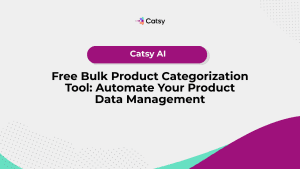How Important Is Product Content to Your eCommerce Business? Shocking Stats

In this Article
The importance of quality product content, which plays a crucial role in the success of an e-commerce business, is highly underestimated.
Consumers are Looking for Accurate, Reliable, Robust Descriptions with Lots of Product Information.
Product pages are only complete if they include the information customers need to make buying decisions. A lack of content indirectly tells customers their demands are unrealistic. This is a bad impression for your customers, especially first-time buyers.
According to Statistics, Consumers Research the Internet Product Content to Get Information on Companies, Products, and Services
This is true even more so than with traditional advertising media. Proactive companies move with trends to deliver top-notch, compelling product content that draws customers to their e-commerce stores.
Your Content can’t be Dry and Bland.
It reflects who you are as a brand and what you represent. Anyone can write content, but not everyone can write compelling content armed with the power to command the attention of anyone who encounters it.
Your Content Must be Simple and Easy to Understand
This should give you an idea of how vital product content is and why you should not compromise on delivering this content to all your digital sales channels.
(Please review the blog below to read more about the importance of delivering clean product data across your sales channels.)
The Importance of Identifying Buyer Personas
Product content for the wrong group of potential customers is as helpful as no content. A common mistake companies make is incorrectly identifying their target market or not having complete information about it.
Create custom content to reach a specific group and industry-specific content to target a given type of business.
Brands must learn to speak to their target markets in their language. For example, selling cosmetics alone isn’t enough. Selling them in a way that communicates how specific products solve target market problems is key.
How Will You Know How to Solve Their Problems If You Don’t Know Them Well Enough to Speak Their Language?
You need to identify your buyer personas’ interests, understand their demographics, and know which products, services, and media they use.
Know How and Where Your Buyer Personas Search for Product Content
The beauty of websites like Facebook, Instagram, and Twitter is that they give you access to information about customers and insights into their daily lives. A brand can use this information to personalize the customer experience.
If this is too complex, keep the keywords your target market will want to see in mind when creating content. You can write more personalized copy to get the desired positive results: driving sales revenue.
The Importance of Social Media
There are over ten million Facebook apps, and 23% of Facebook users check their accounts at least five times daily.
Meanwhile, LinkedIn has over three million company pages and over one billion endorsements.
According to Search Engine Journal, by 2013, more than fifty-eight million tweets were being sent daily, equal to 9,100 a second, with about 222 million watching other people’s tweets. One can only imagine the numbers today.
The web has undergone a dynamic change, with increasing digital technologies and customers evolving with them. Social media platforms like Facebook, Twitter, LinkedIn, Pinterest, and many others have changed communication from what it used to be.
Proactive Companies are Moving with the Trend and Don’t Seem to be Slowing Down
The outstanding fact is that all these platforms and networks are free to join and quite popular, bringing many opportunities for brands. The hype about these platforms is growing, and businesses must shine brightly with their product content to create buzz about their products and services.
Creating custom content for specific groups is easy when a brand accurately studies its target market’s buyer personas and understands their needs and wants.
What’s More Important is making that Content Stand Out from the Competition, which also Becomes Easier.
Custom Content is typically meant to build an affinity with your existing audience. This content reinforces the brand, communicates the product’s value, and creates new opportunities. Custom Content is the creation of “branded content” for a customer. For the most part, custom content is made for the client to communicate with their existing customers.
Andrew Boars (source)
The Importance of Product Description
When We Talk About Product Content, we can’t ignore the Importance of Describing Product Attributes.
This is the information customers will use the most regarding your product. Simply put, your product description can increase your online sales or cause you to lose customers.
There is power in enticing and well-crafted product descriptions, which are unique and ultimately sell products.
Your eCommerce store removes the possibility of physically touching and feeling your products. Hence, customers will have to rely on your product description to be able to do that in their mind’s eye.
Did You Know that Google Lowers Your Website’s Ranking the More You Post Duplicate Content
This is why original, fresh product content is the key to increasing your ratings and rankings. Low rankings translate to low visibility, as customers will not be able to see or access your product information and make a purchase from you.
An Interesting Product Catalog, with Unique Product Descriptions, Quality Visuals, and an Easily Navigated Interface, Enhances Your Customers’ Browsing Experience
Don’t fall into the trap of just listing product features. Make sure you also explain the benefits of such features and how each perfectly solves a problem, improving the lives of your buyer personas.
Never Underestimate the Power Visuals Can Add to Your Product Descriptions. Adding visual digital assets like high-quality images, video presentations, and CAD drawings will boost sales revenue more than ordinary text.
The idea isn’t to write lengthy descriptions but to adapt the mantra “less is more.” Reduce lengthy descriptions to those that can be easily summarized and use pointers to emphasize your products’ unique selling points.
There is no product for which an engaging description can’t be crafted, even the seemingly “Boring” ones.
You can hire professional copywriters to write interesting descriptions for your brand’s content marketing. Ensure proper proofreading and editing of your product description copy to make it professional and impressive to your customers.
When your product descriptions effectively replace sales assistants, you have done your part as a brand. What is an oral presentation to the offline store, and what are written words for the online store? Use this to your advantage and make it count!
Shocking Stats on Online Reviews
Studies show that more than 88% of online shoppers consult reviews before making a purchase decision, and 40% form an opinion about a product after reading between 1 and 3 reviews.
Online reviews are essential as they allow customers to share their experiences with products. Of course, we know customers quickly broadcast their experiences to the web, especially if dissatisfied.
A Survey Conducted by Dimensional Research Revealed 90% of its 1,046 Respondents Claimed Positive Reviews Influenced Their Buying Decisions
86% stated the Opposite, that Negative Reviews Influenced Them
This doesn’t diminish the importance of negative reviews as they’re a golden opportunity for companies to improve operations and turn angry consumers into loyal customers.
A Single Review can be Shared Across Social Media, Further Increasing the Visibility of Your Brand and Generating Sales Leads.
Online reviews generated by your product content and positive customer experiences are great ways to develop your online presence. Potential customers will want to know that your business provides positive experiences before they buy.
Online Reviews Provide Them with That Knowledge. Hence, businesses should encourage customer reviews and recommendations because this can significantly impact their business. Therefore, visibility and overall growth.
This is why you must deliver compelling content infused with your brand promise. If you do, customers are more likely to leave positive reviews.
Product Content Consistency and Search Engine Optimization (SEO)
The 3 Cs of customer satisfaction are consistency, consistency, and consistency.
McKinsey & Company (source)
The importance of product content is no longer a topic for debate. However, are we ready to invest adequate time and effort into it? Unless a company is willing to invest in its content, it can’t reap the ROI that is sure to come.
The Best Way is to Consistently Create and Promote the Right Content to the Right Target Market.
You can’t undertake web marketing without compelling and attention-worthy product content. A study conducted by eMarketer revealed that about 60% of marketers create at least one piece of content every day.
You may wonder why you must invest time in product content when traditional media provides similar results. However, a DemandMetric study revealed that content marketing costs 62% less than conventional marketing.
It Also Generated Three Times as Many Leads
While the importance of advertising in traditional media is valid, your product content has a higher possibility of turning your customers into brand loyalists. SEO will help you rank highly on search result pages, like Google. Consistency in creating great product content will help you maintain that ranking.
The Major Focus of SEO is Increasing the Relevance and Authority, or Quality and Popularity, of Your Website
To optimize your site, title tags must display short previews of specific pages. Metadata descriptions of pages on search pages, headlines, and body copy must also be used. Using keywords in your content is also critical.
Oftentimes, Marketers Understand Product Content and SEO as Separate
These actually blend together, and they have a symbiotic relationship. While SEO can bring in the demands, your product content should fulfill those demands and keep customers coming back for more.
Your Product Content Boosts Your SEO, and Your SEO is All About Your Content
Content is indeed king as SEO can’t thrive without it. In other words, your SEO dreams can only become a reality if you deliver top-notch product content worthy of earning repeat customers.
Your Customers Must be Willing to Spread the Word for You
For you to succeed in eCommerce, there must be a perfect blend between the two. They must also complement each other. There’s no shortcut to doing this.
Whatever angle you look at it, everything still boils down to your product content.
How Product Content Influences Consumer Product Purchases
Competition is increasingly fierce, and getting customers to notice you is as hard to achieve as ever. The best way to accomplish this is with engaging content, especially in the digital world of today’s modern sales channels.
A Good Site Lacking in Great Product Content does not reinforce the Connection Between Their Customers and the Brand.
Good content attracts customers who stay long enough to read, discover, and click. They should long for the brand experience you give them.
Larger Companies Today aren’t Capitalizing on Their Content Because They Know the Benefits They’re Sure to Derive
With strong content, small startups can compete globally with established brands online. They scale the hurdles they may have encountered in the era before digitalization.
There is No Limit to the Reach of Content
Knowing there is an increase from all angles, large companies are placing more bets on content marketing than ever. Content has the power to implant a product in the minds of potential customers, thus generating leads for the company.
Consistently Good Content will Generate Interest in Your Site, Driving Traffic and Revenue.
Producing informative, accurate, and valuable industry content will build trust and communicate your authority to your customers. Constantly feeding your customers engaging content gives them a reason to invest in your brand. Of course, this investment is their time, effort, or money.
All of These Investments Drive Customers to Become Loyal for Life
Customer Loyalty is the End Goal
Please note that the fact that a brand has attracted buyers to its site doesn’t necessarily guarantee they’ll remain customers for life. You may argue that getting customers can be more demanding than keeping them, but this isn’t true in the competitive digital space.
These Times Call for More Personalized Offerings to Solve Customer Needs
This is especially true for brands that want to achieve deeper customer engagement. Your content communicates your expertise in a particular field and builds customer trust.
This Trust will Eventually Translate into Loyalty.
Customer loyalty is reflected in customers’ willingness to repeat purchases from your brand. Customer loyalty should be seen as a top strategic priority in companies, emphasizing the creation of unique digital experiences.
When brands surpass customers’ expectations and delight them, they become your biggest advocates. Brands that aim for customer loyalty are well on their way to the top and will have a greater competitive advantage.
Studies Show Getting a New Customer is Six to Seven Times Costlier Than Keeping an Old One
The goal should be turning existing customers into loyal ones while scouting new prospects.
Loyal customers are worth up to ten times as much as their first purchase
White House Office of Consumer Affairs (source)
Deliver great content with a superb brand experience that makes you stand out.
(To read more about choosing the product information management solution to make sure your product content is always accurate and up-to-date, please review the blog below.)
Make Product Content Management Your Key to Success
Product content in eCommerce means more than just giving a basic description. It affects purchase choices, optimizes search engines, and encourages trust. Today’s digital market requires brands to use effective methods and tools to keep their content high quality, always consistent, and performing well.
Using Product Information Management Benefits
Using efficient systems makes good product content possible. A PIM tool makes accessing, managing, and releasing different product data simple. With the help of PIM software, merchants can manage pricing and features fast and with 100% accuracy.
If you have many items to manage, product content management ensures fewer mistakes, makes your employees more efficient, and assists with further growth.
Improve how your team handles work using a PIM DAM System
It is necessary to join product details with digital resources. A PIM DAM system combines product attributes and top-quality pictures, videos, and documents. The method adds comfort to shopping by cutting out possible inconsistencies.
For PIM ecommerce businesses, it tremendously increases engagement and offers greater value on product pages.
Using Product Content Syndication Can Increase Your Company’s Efficiency
You cannot go without product content syndication if you sell on Amazon, Walmart, or your site.
With innovative product catalog management software, you can immediately update your data on different online stores. AI cuts down repetitive work, hides outdated information, and displays your brand the way you prefer.
Treat Info Management as an Important Priority
Exact and correct information helps people make proper decisions. Information management failure can put you at risk of misleading your customers with the wrong or outdated product information.
With a good PIM ecommerce strategy, your team has all the information required to find problems, fix them, and introduce products more rapidly. It is also easier for marketing, sales, and IT to share and edit files with each other.
How Following a Pattern Generates More Sales
The same look and feel on every platform increases buyers’ trust. Customers trust your brand when each product has the same descriptions, specifications, and images. This is where product catalog management software and a strong PIM DAM system come into play. With these tools, each channel—your site, a marketplace, a page, or an ad—shows the exact and correct content. When images and information are fresh, content that never changes helps prevent people from leaving the site early or giving up before buying.
Consistency in digital media is essential, since it results in higher conversions for your business and customer trust.
An Engaged Shopper Is a Happy Customer
Your content should help you establish an emotional connection with your customers. Your product’s solution is the essence of your brand offer.
Few Brands Understand the Real Power of Their Product Descriptions
This is why you find descriptions of one sentence or nothing at all. How do you convince your customers you’re the best solution to their problems? Words used and information conveyed matter most.
For Your Descriptions to be Persuasive, They Should be Unique and Specifically Tailored to Your Target Market
They should also communicate key product selling points and necessary information in an easy-to-read format that the customer understands. If customers do a quick scan, they should understand everything perfectly.
The Truth is, product Content isn’t Just About Writing Compelling Descriptions.
You must give your customers all the information they need to make informed decisions. These decisions should also add value to their lives. This will help you build a brand that will stand the test of time.
Grading Content as You Create and Post it will Help You Identify which Needs Improvement and which should be Deleted.
Finding customers isn’t the problem. Once you’ve defined your target market, you’ll see they’re everywhere. The challenge is to create tailored content compelling enough to make them want to know more about your product offerings. Do this by taking care of the key elements that make up engaging content.
Finish by Wrapping Everything in the Bow of Consistency
Finally, you have no excuses as a brand for not providing a tailored and personalized content experience. It must also be captivating enough to interest your customers. After all, as they say, an engaged shopper is a happy customer!
Now that you know how vital product content is in eCommerce, click here to see what Catsy can do for you.
Product information management (PIM) is a catalog software tool built to speed products to market.
Digital asset management (DAM) is a software used to organize and enrich digital assets.




